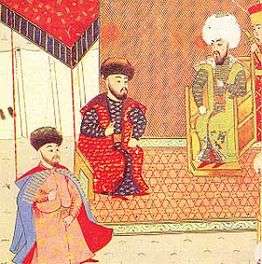Ayşe Hatun (wife of Selim I)
This article is about the daughter of Meñli I Giray of Crimean Khanate, wife of Ottoman Sultan Yavuz Sultan Selim. For the mother of Suleiman the Magnificent, see Hafsa Hatun Sultan.
For other uses, see Ayşe Hatun.
| Ayşe Hâtun[1] عایشه خاتون | |
|---|---|
| Born |
Ayşe (A'ishā) Crimean Khanate |
| Died | Istanbul, Ottoman Empire |
| Religion | Islam |
| Spouse(s) | Selim I |
| Children | Beyhan Sultan, Hâfize Sultan and Şah Sultan [1] |
| Parent(s) | Meñli I Giray of Crimean Khanate[2] |
Ayşe Hâtun II (1476-1539), was a daughter of Meñli I Giray. She married first Mahmud, a son of Bayezid II; after Mahmud's death she married in 1511 his brother Selim I, then still a prince.[2] Ayşe Hatun was married firstly in 1504 to Selim's brother Şehzade Mehmed, Sancak Bey of Kefe, son of Ferahşad Hatun and became widow by his death in 1507. After her first husband's death, the Crimean princess entered in 1511 the harem of her husband's brother, the future Sultan Selim I (1513–20),[3] when he was the governor of Amasya, thus securing for him, in the person of her powerful father, a valuable ally in the prince's struggle for the throne.[4]
She was the mother of Beyhan Sultan, Hâfize Sultan and Şah Sultan. [1]
See also

The father of Ayşe Hatun II Meñli I Giray of Crimean Khanate at the court of Ottoman Sultan Bayezid II.
References
- 1 2 3 The Imperial House of Osman - 4
- 1 2 Alderson, The Structure of the Ottoman Dynasty, tables XVIII and XXIX
- ↑ Ilya V. Zaytsev, The Structure of the Giray Dynasty (15th-16th centuries): Matrimonial and Kinship Relations of the Crimean Khans in Elena Vladimirovna Boĭkova, R. B. Rybakov (ed.), Kinship in the Altaic World: Proceedings of the 48th Permanent International Altaistic Conference, Moscow 10–15 July 2005, p.341
- ↑ Maryna Kravets, From Nomad's Tent to Garden Palace: Evolution of a Chinggisid Household in the Crimea in Gillian Long, Uradyn Erden Bulag , Michael Gervers (ed.) History and society in central and inner Asia: papers presented at the Central and Inner Asia Seminar, University of Toronto, 16–17 April 2004, Asian Institute, University of Toronto, 2005, p.53 on line
This article is issued from Wikipedia - version of the 10/22/2016. The text is available under the Creative Commons Attribution/Share Alike but additional terms may apply for the media files.